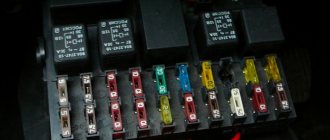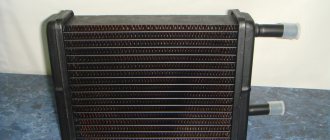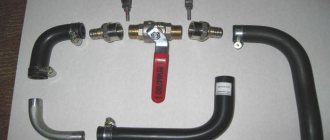What is an electric heater valve?
Electric heater valve (heater control valve with electric drive, heater valve) is a component of the vehicle interior/cabin heating system; a tap or valve to control the supply of coolant from the engine cooling system to the heater radiator (heat exchanger).
An electrically operated faucet is similar to a mechanical faucet, but is driven by a built-in electric motor or solenoid. This solution made it possible to abandon the cable drive and implement control of the heater using a button. Electric cranes make it possible to implement various schemes for heating the interior and operating the engine cooling system, while they are easy to use, reliable in operation and have a simple design.
Repair
Once it has been determined that the electric crane is faulty, it must be dismantled. For this:
- Drain the coolant from the vehicle's cooling system into a prepared container.
- Disconnect the terminals from the heater electric valve.
- Loosen the clamps on the pipes and disconnect them.
- Disassemble and determine the causes of failure. There may be several of them:
- the electric motor has failed,
- the electrical board is burnt out,
- the gearbox for opening and closing the shutter has failed,
- the oil seal is leaking,
- the body burst.
- If it is possible to replace parts without replacing the entire mechanism, then such an action would be advisable if you have spare parts in stock or can purchase them for little money. Because, having changed one of the parts, with a high degree of probability you can expect that the other one will soon fail. Of course, it is better to replace the entire element assembly, but this is not always possible.
Types, design and operating principle of electric heater valve
Electrically controlled faucets existing today are divided into groups according to the type of shut-off element and its drive, and according to the number of circuits (and, accordingly, pipes).
Based on the number of circuits and pipes, heater valves are:
- Single-circuit / 2-pipe - ordinary taps / valves;
- Double-circuit / 3-pipe - three-way valves.
Double-port valves are valves that can only open and close the flow of liquid. In such a faucet, one pipe is inlet, the second is outlet, and between them there is a shut-off element. The dual-port heater valve is used in conventional interior heating systems and is located between the engine cooling system outlet and the heater core inlet to control the flow of hot coolant.
Three-way valves are three-way valves that can direct fluid flow into two different pipelines. This faucet has one inlet and two outlets, and the shut-off element is designed in such a way that it can direct liquid from the inlet to one of the outlets while simultaneously blocking the other. A heater valve with three pipes can be used in various interior heating systems: with bypass, with an additional heater, etc.
According to the type of shut-off element and its drive, taps are:
- Gate valves driven by an electric motor;
- Shut-off valves driven by a solenoid.
The design of gate valves is simple. They are based on a plastic molded body with pipes, inside of which there is a rotating plate in the form of a solid sector or a sector with holes the size of the pipes. A compact electric motor with a simple gear reducer is installed on the housing, with the help of which the plate rotates. In faucets with two nozzles (double-circuit), both nozzles are located opposite each other, with a plate between them. Three-way faucets have an inlet on one side and two outlets on the other.
The heater valve with an electric motor works as follows. When the heater is turned off, the valve plate is located between the pipes, blocking the flow of liquid - in this case, hot liquid does not flow into the heater radiator, and the interior heating system does not work. If it is necessary to turn on the stove, the driver presses a button on the dashboard, current is supplied to the electric motor of the faucet, it turns the plate and opens the path of coolant - the heater radiator heats up, the interior heating system begins to work. To turn off the heater, the driver presses the button again, all processes occur in reverse order, and the heater turns off.
A heater tap with three pipes also works easily if there is a bypass in the heating system. When the heater is turned off, the rotary plate is in such a position that the coolant passes through the tap and through the exhaust pipe enters the inlet of the engine cooling system (to the pump). When the heater is turned on, the plate rotates, closes one outlet pipe and opens the second - now the fluid flow freely passes into the heater radiator, and from it enters the exhaust pipe and the inlet of the engine cooling system. When the stove is turned off, all processes occur in reverse order.
The design of shut-off solenoid valves is different. They are based on a plastic case, inside of which there is a lifting valve in the form of a truncated cone. In the closed position, the valve sits on its seat, blocking the flow of liquid. The valve is connected via a rod to the solenoid armature, which is mounted on the valve body. Double-circuit valves can be single- or double-solenoid. In the first case, both locking elements are located on the solenoid rod, in the second, each locking element is controlled by its own solenoid.
The operation of the heater solenoid valve is also simple. The valves are normally open - without voltage on the solenoid, the valve is raised by a spring, the channel is open. When the engine starts, voltage is applied to the solenoid and the valve closes. When the stove is turned on, the solenoid is de-energized, the tap opens and supplies hot liquid to the heating radiator. When the stove is turned off, voltage is supplied to the solenoid again and the tap closes. A dual-circuit valve works in a similar way, however, one of its circuits is always closed when the ignition is turned on - this prevents the supply of coolant to the heater radiator; the liquid flows through the bypass. When the heater is turned on, the circuits switch, the coolant flows to the heater radiator, and when the heater is turned off, the valve returns to its original position. Both solenoids of a double-circuit valve never open or close at the same time (except during a complete blackout, when both valves are open).
The tap pipes of all types are serrated; this shape ensures a tight fit of the rubber pipelines. Installation of pipelines on branch pipes is carried out using metal clamps; the tap itself usually hangs freely on the pipelines (since it has a low mass). The tap is connected to the electrical system using a standard electrical connector.
Today, electric heater taps are widely used on domestic and foreign cars; they have practically replaced their mechanical counterparts and made control of the interior heater more convenient.
heater tap gazelle business electrical principle of operation
The heating system for GAZelle GAZ-3302 and GAZ-2705 is designed for continuous operation for a long time. It provides multiple exchanges of air in the cabin and the required air temperature in the cold season.
The liquid heats the heater radiator, the fan blows air, which, passing through the honeycombs, heats up and spreads throughout the cabin. Gazelle Business stoves are equipped with an electronic control unit that can control the heater both automatically and manually. To do this, it has a cabin temperature sensor that allows you to maintain the set temperature.
The tests were extremely successful. When the supply to the stove in the cabin is closed, the pipes are cold. When you open it, it’s immediately fiery. Everything works as intended.
Original A21R23.8109030 ………………………………………………………. WHOLESALE AND RETAIL WAREHOUSE OF SPARE PARTS. Cash and non-cash payments. ……………………………………………. In stock! Pickup. Delivery in Moscow and Moscow Region.
The heater valve with an electric motor works as follows. When the heater is turned off, the valve plate is located between the pipes, blocking the flow of liquid - in this case, hot liquid does not flow into the heater radiator, and the interior heating system does not work.
Passing through a heated heater radiator (included in the engine cooling system parallel to the main radiator), the air is heated and supplied to the passenger compartment.
Questions about choosing and replacing a heater tap
The heater valve is very important for the operation of the interior/cabin heating system, however, selecting and replacing this part in most cases does not cause any problems. To select the right faucet, you must follow several recommendations:
- The power supply voltage of the crane motor must correspond to the voltage of the vehicle’s on-board electrical network - 12 or 24 V;
- The type of tap - 2 or 3 pipes - must correspond to the interior heating system diagram. For conventional systems, a tap with two pipes is required; for systems with bypass, a tap with three pipes is required. Also, a tap with three pipes can be used to create a heating system with an additional heater;
- The diameter of the pipes must correspond to the diameter of the heating system pipelines, but if necessary, adapters can be used;
- The faucet and vehicle must have the same type of electrical connector. If necessary, it is necessary to replace the type of connector on the vehicle;
- The crane must have dimensions suitable for its installation.
The heater valve must be replaced after draining the coolant; metal clamps must be used for installation. It is necessary to ensure that the tap is installed correctly - position its inlet and outlet pipes in accordance with the direction of the liquid. For convenience, there are arrows on the nozzles indicating the direction of fluid flow. If you install a regular 2-pipe valve incorrectly, the system will work, but incorrectly installing a 3-pipe valve will make the system completely inoperable. If the faucet is installed correctly and reliably, the stove will start working immediately, providing warmth and comfort in the car interior.
Replacing the heater tap
For convenience, remove the electric pump of the additional heater.
Use a screwdriver to loosen the clamps on the inlet and outlet hoses.
Disconnect the hoses from the tap.
Using a 10mm wrench, unscrew the cable fixing bolt 2-3 turns.
Using the same key, unscrew the two bolts securing the faucet
Removing the faucet from the car
Install the faucet in reverse order
We assemble all the parts in reverse order.
The importance and benefits of the interior heating system are felt only in the cold season. When summer comes, the need to use the system disappears. But, as you know, you need to prepare a sleigh in the summer. In the summer, daylight hours are longer, and the weather is conducive to quick and high-quality repairs. First you need to understand how the heating system in a car is designed and functions. On a Gazelle Business car, as on all cars with a liquid-cooled engine, a stove is installed, into which heat is supplied from the heated parts of the engine through coolant. The liquid heats the heater radiator, the fan blows air, which, passing through the honeycombs, heats up and spreads throughout the cabin. Gazelle Business stoves are equipped with an electronic control unit that can control the heater both automatically and manually. To do this, it has a cabin temperature sensor that allows you to maintain the set temperature. All adjustments are electric, and not on cables, as in previous versions. The dampers are controlled by gearmotors, and the temperature is controlled by an electric valve (reducing or increasing the amount of coolant passing through the radiator). All controls are placed on the front panel, which is very convenient and does not distract the driver from driving the car. But any equipment sooner or later malfunctions.
Design of the cooling system for UMZ-4213 and UMZ-4216 engines on UAZ and GAZelle vehicles.
To increase energy performance, improve fuel efficiency, reduce toxicity and noise, models with an integrated microprocessor fuel injection and ignition control system were developed on the basis of the UMZ-421 carburetor engine: the UMZ-4213 engine for UAZ cars and the UMZ-4216 engine for GAZelle cars. The design of the cooling system on the UMZ-4213 and UMZ-4216 is somewhat different, since it has differences in the connection diagram of the expansion tanks and heating radiators.
General design of the cooling system of UMZ-4213 and UMZ-4216 engines on UAZ and GAZelle vehicles.
The cooling system is liquid, closed, with forced circulation of liquid and an expansion tank, with liquid supply to the cylinder block. Includes a water pump, thermostat, water jackets in the cylinder block and cylinder head, radiator, expansion tank, fan, connecting pipes, as well as body heating radiators.
For normal operation of the UMZ-4213 and UMZ-4216 engines, the coolant temperature must be maintained within plus 80-90 degrees. It is permissible to operate the engine for a short time at a coolant temperature of 105 degrees. This mode can occur in the hot season when driving a car with a full load on long climbs or in urban driving conditions with frequent accelerations and stops.
Design of the UMZ-4213 engine cooling system on a UAZ vehicle.
Design of the UMZ-4216 engine cooling system on a GAZelle car.
Operation of the cooling system of UMZ-4213 and UMZ-4216 engines on UAZ and GAZelle vehicles.
Maintaining normal coolant temperature is carried out using a two-valve thermostat TS-107-01 with a solid filler. When the engine warms up, when the coolant temperature is below 80 degrees, a small circle of coolant circulation operates. The upper thermostat valve is closed, the lower valve is open.
The coolant is pumped into the cooling jacket of the cylinder block by a water pump, from where, through holes in the upper plate of the block and the lower plane of the cylinder head, the liquid enters the head cooling jacket, then into the thermostat housing and through the lower thermostat valve and connecting pipe to the inlet of the water pump. The radiator is disconnected from the main coolant flow.
For more efficient operation of the interior heating system when circulating liquid in a small circle, and this situation can be maintained for quite a long time at low negative ambient temperatures, there is a throttle hole with a diameter of 9 mm in the liquid outlet channel through the lower valve of the thermostat. Such throttling leads to an increase in the pressure drop at the inlet and outlet of the heating radiator and more intense circulation of liquid through this radiator.
In addition, throttling the valve at the liquid outlet through the bottom valve of the thermostat reduces the likelihood of emergency overheating of the engine in the absence of a thermostat, since the shunting effect of the small circle of liquid circulation is significantly weakened, so a significant part of the liquid will go through the cooling radiator.
Additionally, to maintain the normal operating temperature of the coolant during the cold season, UAZ vehicles can have shutters installed in front of the radiator, with which you can regulate the amount of air passing through the radiator.
When the liquid temperature rises to 80 degrees or more, the upper thermostat valve opens and the lower valve closes. The coolant circulates in a large circle through the radiator.
For normal operation, the cooling system must be completely filled with liquid. When the engine warms up, the volume of liquid increases, its excess is pushed out due to increased pressure from the closed circulation volume into the expansion tank. When the temperature of the liquid decreases, for example after stopping the engine, the liquid from the expansion tank, under the influence of the resulting vacuum, returns to a closed volume.
On UAZ vehicles with a UMZ-4213 engine, the expansion tank is directly connected to the atmosphere. The regulation of fluid exchange between the tank and the closed volume of the cooling system is regulated by two valves, inlet and outlet, located in the radiator plug.
Gazelle stove diagram
The design of the stove heater valve and the principle of operation
The faucet is attached to the stove radiator using bolts. Using a lever and a control cable, the faucet is connected to a lever on the front panel. By switching the interior lever to the blue or red zone, the motorist opens or closes the tap. Using hoses extending into the engine compartment, the faucet is connected to the general engine cooling system. It is through the hoses that coolant flows into the heater radiator.
When the valve is open, the coolant passes through the heater radiator and heats its metal surface. The air forced by the fan is heated from the surface and warms the interior.
Gazelle stove faucet - electric principle of operation
The owner of a long gazelle business came to us from the distant northern Urals, the city of Novy Urengoy, with a complaint about a faulty stove, he says the stove doesn’t heat at all, but he bought this workhorse second-hand the other day and didn’t check the functionality of the stove, so we need to figure out the fault. Errors E3 and E7 (E3 and E7) light up on the display.
And so, we begin the check with a visual inspection of the heater control unit (HCU) 2705-8121020. E3 lights up on the display . Looking ahead, let's say that this malfunction is associated with the heater damper gear motor (90.3780) or MP-2-01 , which is located next to the driver’s right foot under the panel. Looking under the panel and deciding to check whether both connectors were latched, we did not find this gear motor, but only the connectors were dangling. Apparently the previous owner removed the gear motor, but did not install a new one. We install a new gear motor.
Video. Checking the heater damper gear motor (90.3780) or MP-2-01 .
2 errors with this gear motor ( 90.3780 ) E3 – malfunction of the damper position sensor ( rheostat ), which determines the current position of the damper. E6 – a malfunction of the motor itself, the gear motor that controls the damper.
We check the functionality of the heater and turn on the ignition. Error E3 disappeared, but error E7 . The stove still blows cold air, although the gear motor 90.3780 is working properly. Next, we check the heater tap, because it is responsible for supplying hot coolant to the heater radiator, and it is also the reason why error E7 . We set the temperature regulator on the control unit to the hottest position and check by hand the hoses going to the heater radiator.
Both of our pipes going to the heater radiator turned out to be cold, although the pump is working and the supply hose to the faucet is hot, which means for some reason the faucet does not open. The easiest way to check the operation of the faucet is to turn the temperature control to maximum and minimum with the car turned off. The stove tap should make characteristic clicks, indicating its operation. But we didn’t hear any sounds, so we’re conducting a more detailed check. We start by checking the heater tap connector.
Types of stove heater taps
There are several types of heater taps suitable for one car model.
- Standard factory plastic faucet with a rubber membrane as a locking mechanism. As is often the case with domestic car models of past years, this crane is the least expensive and the most unreliable. Such a faucet “likes” to oxidize, stick and rust.
- Ball valve. In such a unit, instead of a rubber membrane, a ball with holes is installed. This design of the part is much more reliable, but still does not prevent oxidation. The cost of a ball valve is much higher than a standard factory one.
- The ceramic heater tap consists of a plastic body and two ceramic plates that perform shut-off functions. The most reliable option for a stove heater tap, however, due to the low throughput of a ceramic tap, its heat transfer is low. In addition, ceramic taps are prone to leaks. A ceramic tap is the most expensive option for stove heater taps.
Heater heater valve malfunction
Since the tap is not used during the warm season, when turning on the stove during cold weather, the driver may encounter a malfunction. There are three main problems with the heater valve.
- Faucet souring due to prolonged non-use of the stove during the warm season. In spring, summer and autumn, the stove is used only for air ventilation, so the tap switch lever is moved to the extreme left position. During this period, the faucet damper may become sour, which makes it impossible to turn on the stove. In the early stages, the malfunction is manifested by a weak supply of hot air, even with the damper open as much as possible. If you use excessive force when the faucet turns sour, you can completely break it. The malfunction cannot be called critical, but it must be eliminated before the winter cold.
- Faucet leakage due to depressurization of the body, when the O-rings and seals wear out, which leads to incomplete closure of the faucet. The consequence of this is a decrease in the level of coolant in the tank and, accordingly, in the entire engine cooling system. A leaking faucet is manifested by wet spots on the carpet, the smell of antifreeze in the cabin, and a grease mark on the bottom of the windshield.
- Faucet jamming with antifreeze decomposition products and other debris. The malfunction manifests itself in a similar way to a souring faucet, but its cause is different. Antifreeze deposits and dirt accumulating in the faucet mechanism lead to jamming of the faucet, which makes it impossible to regulate the level of liquid entering the heater radiator.
If souring and jamming of the faucet is a serious, but not critical breakdown, then it is better to fix the malfunction associated with the leaking faucet as soon as possible. Otherwise, due to a decrease in the coolant level, the entire cooling system of the car’s engine may suffer.
Heater valve for the gazelle business stove
If it is possible to replace parts without replacing the entire mechanism, then such an action would be advisable if you have spare parts in stock or can purchase them for little money. Because, having changed one of the parts, with a high degree of probability you can expect that the other one will soon fail.
The radiator core is made of aluminum tubes and aluminum cooling fins. A metal bottom with a rubber gasket is installed on both sides of the core. The gasket seals the ends of the tubes, and the tank installed on this gasket is pressed against the gasket with bending tendrils. Ball valves for gas should be of high quality, from reputable manufacturers. The perfect combination of progress and simplicity makes these taps a good seller. And more and more people prefer just such faucets.
What to do if the interior heater does not heat, or heats poorly. What to do and what are the reasons for such a breakdown. Let's look at the six main steps. Fast..
Prevention of malfunction of the heater valve
Preventative maintenance of the heater valve allows you to prevent early failure of the mechanism. In order not to be left with a non-working stove before the start of the “heating season”, it is necessary to switch the lever from the red zone to the blue zone and back from time to time. This will prevent the heater tap from souring and jamming.
It is also necessary to carefully monitor coolant leaks in the car interior - for example, from time to time lift the rugs and examine the floor of the car for stains from leaking coolant.
System modernization
The main problem that causes electronics to fail is moisture. And in the tap the liquid circulates constantly, even when the shutter is closed. And when the oil seal leaks, liquid floods the entire electrical part, and it fails.
Installation of shut-off valves
To avoid this, you can install conventional shut-off valves, fitting them to the outlets of the cooling system. But in order to open or close the supply of hot liquid, you need to move the tap to the desired position manually. And since it is installed under the hood (in a regular place), it is not possible to do this while driving. But this mechanism has a much greater resource.
Pre-sealing
Before installing a new electric faucet, you need to disassemble it and fill the electronic board with hot glue to avoid moisture getting on it, coat all joints with sealant. This method can only prolong performance, because if liquid gets into the electronic part, the electric motor will be damaged, without which the mechanism will not be able to function correctly.
Replacing the heater valve
The heater valve mechanism is so simple that it cannot be repaired. The malfunction can be eliminated by replacing the assembly part itself. To do this, you will have to work hard, since replacing a faucet requires access to it both from the interior and from the engine compartment and from under the bottom of the car.
- First you need to place the car on a flat surface. You need to place an empty container under the radiator into which you can drain the coolant from the radiator.
- Next, you need to move the container under the car engine and drain the “coolant” from the engine. To do this, you need to unscrew the special bolt on the block on the left side.
- Then you need to loosen the screws of the clamps from the engine compartment that secure the hoses connecting the faucet to the engine cooling system. After this, the hoses must be removed from the tap pipes.
- After this, you need to loosen the screws of the hose clamps on the tap side. To do this, you will have to go into the car interior and remove the plastic dashboard cover. After the screws have been loosened, you need to remove the hoses where they are attached to the heater radiator.
- From the engine compartment, unscrew the nuts holding the valve.
- After this, the faucet can be removed from the car interior. All that remains is to disconnect the rod connecting the crane to the control lever on the front console. To do this, using pliers, you need to disconnect the bracket on which the rod is attached. After this, the tap can be finally removed.
Installing a new heater tap is done in the reverse order, except for one thing. First, the hoses connecting the faucet to the engine cooling system are connected, and only then the bracket and rod are installed. After this, coolant can be added to the system.
Electric valve for the gazelle business stove
Because You are not logged in. To come in.
Because The topic is archived.
For those who are interested in tinkering with domestic cars. Others can safely skip this thread.
Background of the problem. The standard heater valve on my Volga lived for one season and began to mercilessly poison antifreeze in the closed position, which makes the cabin hot in the summer. I replaced it with a new one earlier this summer. It was enough for 10 openings and closings. And my friend at seven has the same story. And it flows, too. By the way, I replaced the old one a long time ago. The ceramic leaked after a year of use. In short, 2 weeks ago I bought a solenoid valve made in Ryazan. The kit is intended for all domestic cars. I set it to seven for myself and my friend. Both are happy. It works like a charm (at least these 2 weeks). It doesn’t poison anything, and stably maintains the temperature at which it is set. The kit includes the valve itself, a control unit, a temperature sensor and a temperature regulator with all the wires, which were enough for both the Volga and the Lada. The sensor is inserted into the air pipeline immediately after the stove, and the temperature regulator - a simple resistor with a handle - is placed in any convenient place. The kit suggests inserting it instead of the key cover. The regulator is supplied with a Zhiguli plug. The installation took an hour and a half, with some head scratching and cognac drinking. Naturally, everything was done without draining the coolant. I crimped the hoses with simple clamps in the range 14-22. The diameter of the valve pipes is 16 mm. Those. It fits into the Lada without any questions, but on the Volga they now use 18 mm fittings. The question arose... But, as it turned out, the fitting is easily pressed with a clamp and does not leak. Hoses with a wall thickness of more than 2 mm are easily crimped around a fitting that is 2 mm smaller than the inner diameter of the hose. Our machines use 3.5-5 mm hoses. In general, finally, when driving around the city and on the highway, air at outside temperature blows into the cabin, and not heated air, like in the kitchen. And the best part is that you don’t have to click the fan buttons in winter, turning it off when it’s too hot and turning it on when it’s cold. It will blow constantly, and the temperature is regulated by automatic closing and opening of the valve based on the readings of the cabin temperature sensor. I bought both sets at the Sormovo turn in a small OKA-GAZ store, located on the side, between two large stores. It's called cool - SUOS. ¶











